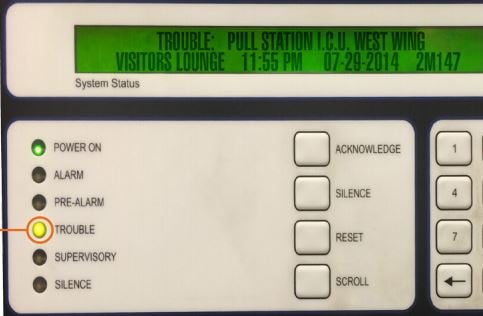One of the more common issues reported to our service technicians is "My fire panel trouble light is on and cannot be turned off." There's often a misunderstanding that a trouble light can be reset, like a fire alarm or other notification. This is not the case; trouble signals indicate that there is a larger issue somewhere in the system that must be resolved before the signal can be cleared.
NFPA Code Surrounding Trouble Signals
As defined by NFPA code, a trouble signal is "a signal initiated by a system or device indicative of a fault in a monitored circuit, system, or component (NPFA 72)." Also known as "troubles," these signals allow facility managers to identify and resolve an issue before it snowballs into a larger problem.
NFPA 72 requires that trouble signals have distinctive audible signals that can be identified without confusing it with other alerts or a nearby appliance. It should be emitted in a room where it is likely to be heard, preferably near an area where the trained person responsible for the system can hear it (NFPA 72). The result is that the whole building will not be notified, but those equipped to resolve the issue will and are nearby.
 To silence a trouble signal, the "Acknowledge" button can be pressed to temporarily turn the signal off. Troubles will sound until manually silenced or acknowledged by the proper personnel with the key to the locked panel enclosure.
To silence a trouble signal, the "Acknowledge" button can be pressed to temporarily turn the signal off. Troubles will sound until manually silenced or acknowledged by the proper personnel with the key to the locked panel enclosure.
Using the Acknowledge button may be a short-term solution that gives your ears a brief reprieve, but it is in no way a solution to the issue at hand. If the trouble is not addressed and fixed, the signal will recur every 24 hours or less. The only way to stop the signals from occurring is to find the source of the trouble and resolve the issue.
Common Causes of a Trouble Signal
Ground Fault
Ground faults can occur in your system when an exposed wire touches grounded metal, a result of poor wiring installation. They also occur over time depending on your building conditions. We've seen troubles triggered when detectors are improperly mounted, or when natural conditions cause the wires to shift during high winds or expand with sunlight.
Circuit Problems
Circuit problems could be the result of many different issues. These include: an open circuit from a disconnected wire, an end of line resistor issue, or intermittent issues from an incorrect wire type. If a circuit issue is left unrepaired, you run the life-safety risk of your suppression system potentially remaining inactive during a fire.
Battery Faults
Dead batteries inside your system are a routine occurrence generating a trouble condition and may be one of the causes of a ground fault. Other battery-related problems that might cause a trouble are charging problems and reversed polarity during installation.
Device Failures
Devices can fail from dirty sensors plagued by dust and debris. A newer and smarter system can self-diagnose contamination. Failures also increase near the end of a device's useful life, which is typically 7 years.
Cures for Common Troubles
All troubleshooting of trouble alerts should be performed by experienced technicians that have access to reliable tools and experience to recognize the source of the problem. They should also practice proper procedures that do not put any lives at risk.
Each trouble has its own types of cures that will allow your system to return to normal. Once the trouble is located and resolved, no further action is necessary. The system will automatically detect that it has been fixed, the signal will stop beeping, and the LCD message will return to “All Systems Normal.”
To find out the cures for the different trouble signal problems, download the complete "Guidebook for Frequent Panel Troubles" by clicking the button below.
References
NFPA (2007) National Fire Alarm Code 72. Retrieved from https://joeklein.cc/page/nfpa/72-2007-PDF%203-31-2009.pdf






